Regenerative Farming Powered by Microbes
Air Date: Week of September 22, 2023
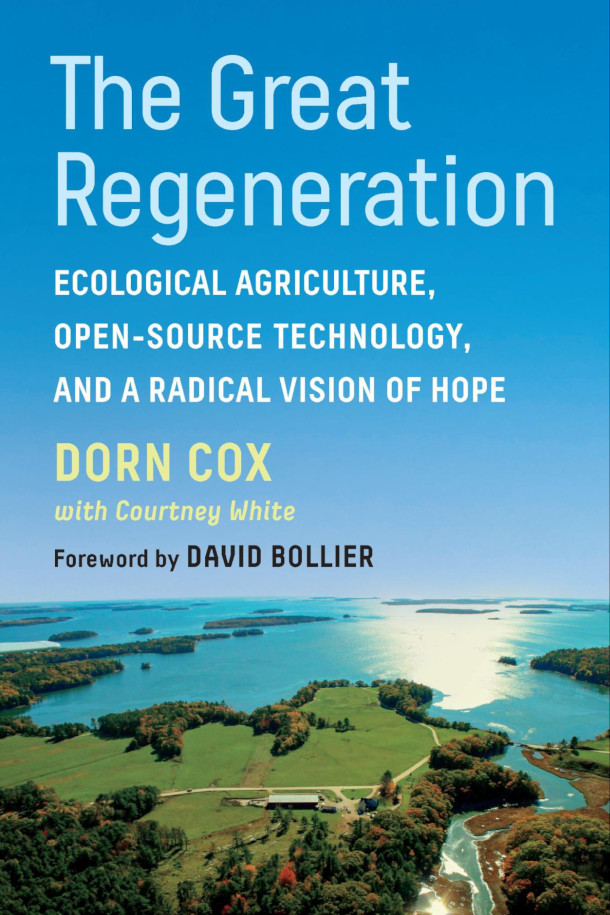
Living on Earth’s Steve Curwood spoke with Dorn Cox about his book, “The Great Regeneration: Ecological Agriculture, Open-Source Technology, and a Radical Vision of Hope” at our live book club event in Dover, NH. (Chelsea Green Publishing)
Microorganisms in soil generate carbon-rich soil and help plants grow, but too often our food comes from industrial farms that limit beneficial microbes by depleting the soil with tillage and toxic chemicals. Farmer and author Dorn Cox joins Host Steve Curwood to describe his collaborative high-tech vision of harnessing the power of microbes outlined in his book The Great Regeneration: Ecological Agriculture, Open-Source Technology, and a Radical Vision of Hope.
Transcript
DOERING: It’s Living on Earth, I’m Jenni Doering
CURWOOD: And I’m Steve Curwood.
Regeneration is increasingly offering hope to people worried about the climate emergency and the rapid loss of species, thanks to better understanding of how microbes grow ecological abundance by putting carbon back in the ground. Trees not only take carbon from the atmosphere to make leaves and wood, they also feed microbes on their roots to generate carbon-rich soil, as do grasslands and organic agriculture. But too often our food comes from industrial farms that limit beneficial microbes by depleting the soil with tillage and toxic chemicals. Microbes made life possible from the earliest days of evolution, so collaborating with them is key to nurturing life on our planet. Farmer and author Dorn Cox offers a hi-tech way to work with climate-enhancing microbes in his 2023 book called The Great Regeneration: Ecological Agriculture, Open-Source Technology, and a Radical Vision of Hope. We talked at a recent live book club event in Dover, New Hampshire.
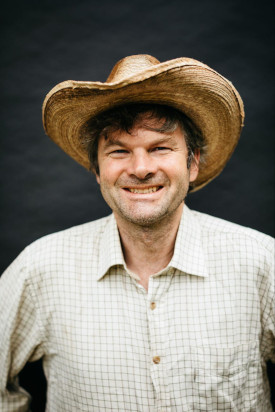
Dr. Cox is a founder of the farmOS software platform and Farm Hack, and he has been internationally recognized for his leadership in developing the Open Technology Ecosystem for Agricultural Management (OpenTEAM). (Photo: Tuckaway Farm)
COX: Regeneration, I think, is not only the opposite of extraction, but it's also an acknowledgment that our involvement with the environment can improve it, and not just degrade it. And that it's also in reaction to sustainability. So if we have sustainability as of sort of a status quo, we're keeping things the way they are. That doesn't necessarily acknowledge that we've done damage. And so what are the things that we can do that actually increase the vibrancy and the productivity of the world around us as opposed to extracting? When I think about regeneration, it's like, how do we become beneficial organisms in our environment? We've proven, as we say, we're part of the Anthropocene, right? We're part of the human epoch. We've undeniably changed the environment around us. If we can change it that way, we can also change it the other way. And at large scales. So from my perspective, it is a quantifiable improvement of the life force that we're participating in stewarding. And I think it is, it's also looking at it from a generational perspective. So regeneration means generation after generation, there's an improvement.
CURWOOD: So what does regeneration look like on the ground? This is a pun that one of our producers suggested we ask you.
COX: So this is something that you can see it sort of at a large scale. And I think that's what we have to do, it's sort of at the planetary scale is, is looking at transforming what we call conventional agriculture into not just producing food, fiber and energy, but producing environmental benefits, as creating public goods as part of the outcome of agriculture. And then that becomes the new conventional. That's what it looks like on the ground, is that every land steward and their community is recognizing that part of what they do is not just feed and fuel the economy, but create these other public goods: clean water, clean air, biodiversity, and climate mitigation, wildfire mitigation, all these public goods that are part of land stewardship. But on an individual level, anybody can see this in their own backyard, if they have, you know, a little sand plot, and they start watching plants grow and transform that sand into soil, which can happen amazingly quickly, that process of carbon in the atmosphere, going into roots, feeding the microbiology there, and seeing the change over time from sand into dark organic matter that produces a condition that's better for the next generation of plants in that same spot. You can see it when dandelions push through the pavement. That's regeneration, is this process of nature filling those voids and being part of accelerating that process.
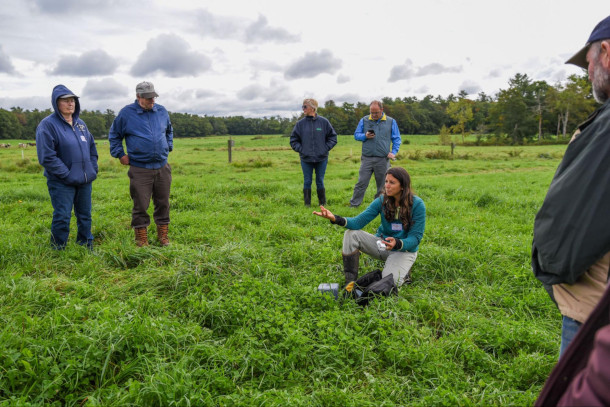
OpenTEAM, or Open Technology Ecosystem for Agricultural Management, allows diverse stakeholders to share agricultural knowledge. (Photo: Wolfe’s Neck Center)
CURWOOD: It's a good reminder to cheer when I see the dandelions. So there's kind of the trope around agriculture these days that, you know, we're short of water, we're short of crops, either they come in, in large numbers, and so there's not much financial abundance for farmers, or they come in short numbers, and there's not much abundance for us consumers. But you say, we have abundance. Expand, please.
COX: Yeah. Well, I mean, I think, you know, it goes back to even the word regeneration, because the foundation of industrial economics is scarcity, right?
CURWOOD: Right.

Dorn Cox is also the research director for the Wolfe’s Neck Center for Agriculture and the Environment in Freeport, Maine. (Photo: Wolfe’s Neck Center)
COX: And that we have a set amount of resources that we have available, and that as we draw them down, they become more dear. And that fundamentally misses the nature of life on Earth, which is regeneration, and recycling, and reuse. And that generationally, it's what created a livable planet in the first place. It created the biosphere, it created oxygen, and the carbon and the nitrogen, the phosphorus that, and the combination of the genetic materials that create things that want to grow everywhere. And so that fundamental nature is missed if we think just about scarcity, and extraction. And so I think that sort of sets up a different kind of economics, which is non rival or regenerative, which is, the more we use it, the more there is of it, potentially. And so that's, so the amount we use in terms of water is a very tiny amount of the available water, often too much. But it's how do we, how do we interact with that? How do we use what's often too much in the wrong place, and be able to harness that? And some of that is like our history that's as old as agriculture, right, is managing water on a landscape. That's some of the first things that we're doing together is managing, creating pools, creating canals, creating irrigation and terraces. Likewise, we're talking about an overabundance of CO2 in the atmosphere. But we have a scarcity of carbon in our soils, but it takes a very small amount of shift between what we have in abundance in the atmosphere, pulled down into plants, transformed with sunlight and water into living tissue that feeds microbes to turn that into soil in the ground where it's productive and can create further abundance.
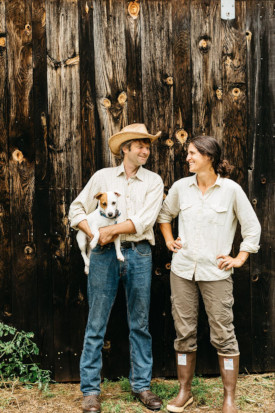
Dorn and his wife, Sarah, farm with their family on 250 acres of land in Lee, NH. (Photo: Tuckaway Farm)
CURWOOD: One of the things that I found just fascinating about your book is that there's no line about doom in there. I mean, some people who are concerned about agriculture will say, well look at what big industrial agriculture has done. It's given us cancer-causing chemicals for genetically modified crops that are grown in rows. It has gone to single monoculture type of landscape. There's none of those complaints in your book. You have hope. And as I was reading it, I was wondering, okay, how's he going to get there? And then I got to this part of your book that's about the power of open source technology to solve these complex problems, so that it's possible for ordinary people who want to farm or who want to engage with farming, to begin to make the kind of changes that you're making. So please explain to us the power of open source, and why you think that this is one of the fundamental levers to make the change to get to your wonderful optimistic vision.
COX: Yeah, absolutely. I think it's one of the most important parts of agriculture that actually has a much longer history in agriculture than what we've seen in terms of the protection of knowledge that's really been the last part of the Industrial Revolution and trying to protect intellectual property, patenting seeds, and trying to patent nature itself, or the ideas. And so I try to frame it, that a lot of what we've seen in the last fifty, seventy years in agriculture is really fairly primitive. And those decisions that were made, were to simplify agriculture, because a lot of these things were hard. And that industrial part was a way to oversimplify.
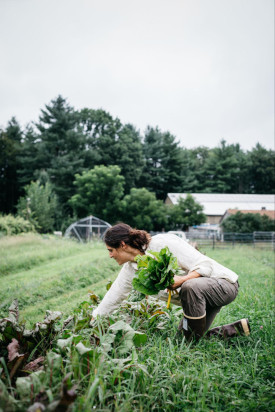
The philosophy of regeneration highlights that humans can have a positive role in stewarding the environment. (Photo: Tuckaway Farm)
CURWOOD: Wait, I mean, if we went to the USDA, they would say, it's modern. You're saying it's primitive, what we're doing.
COX: Well, absolutely, because regenerative agriculture is really looking at harnessing the power of the microbiome. If you think about the genetics involved, there are more organisms in a handful of healthy soil than there are people on Earth. And every one of those has a unique genetic marker. I think there's a line in the book that says, regenerative agriculture isn't rocket science, it's far more complex. But because of that complexity, it requires all of us to take our observations and translate that in a way that we can allow others to build on that knowledge. And that's what open source is. It's the ability of each generation to contribute their observations and improve it. And to create a system that's designed to do that. You know, the idea of agricultural extension goes back to ancient Egypt. It's about observing which wheat plants worked and recommending how to plant them and how to share that with with your neighbor. It goes to every seed that you exchange with somebody is a form of open source agricultural exchange. You've taken your observations of what works and shared it with somebody else. And it doesn't diminish your ability to use it yourself. It's nonrival, is the economic term. Because you use it doesn't mean that I can't also enjoy it in the same way.
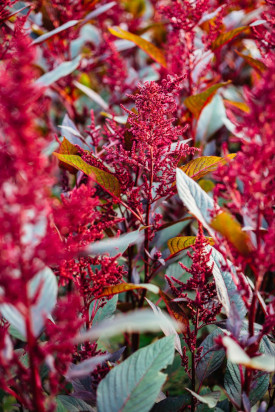
Plants take carbon from the atmosphere and feed the microbes in soil through their roots. (Photo: Tuckaway Farm)
CURWOOD: So the secret then of open source is that really we get to share experience in a positive way, you said, this is not a rival situation, that everybody benefits. And we can use it to improve our lives, and not just lock things away. And so talk to me about an organization that you discuss in your book that you call OpenTEAM. Let me see if I have the acronym correctly: Open Technology Ecosystem for Agricultural Management, right?
COX: That's right.
CURWOOD: That's it. Okay, you helped develop this. So why is, why is this platform so important, in terms of building this community of sharing knowledge?
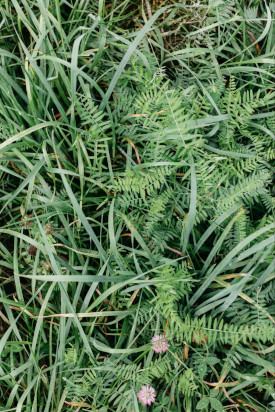
The Earth holds more abundance than we realize, Dorn Cox argues. It’s how we manage that abundance that matters. (Photo: Tuckaway Farm)
COX: Yeah, well, I mean, we now have in our devices, the ability to access all of, you know, human knowledge, at an instant, at very, very low cost. But we have not made that transformation in creating that public utility. When we look at upgrading ubiquitous agricultural knowledge, OpenTEAM was really formed to say, what does that look like? How do we actually aggregate and share our local agricultural knowledge accessible to everybody? Not because there's a business model behind it, but because that's what actually makes the better business models for everything work. Like the internet isn't a business model. But it enabled trillions of dollars of business on top of it. It's a public utility. So if we're looking at what is a knowledge utility that brings access to this important knowledge to grow food and transform and improve your own environment, isn't that something that should exist? And shouldn't we all have a role in actually contributing our knowledge and our observations and share those recipes in terms of what works where? Because part of it is intensely local, and part of it is something that we can put out and share globally. And so we recognized also that it isn't something we do by ourselves. It's also in partnership with government agencies, and research universities, and food companies, and farmer organizations. So we launched it with about a dozen organizations, now more than 45 organizations, and now working directly with the USDA as they're developing their data strategies for data collection for greenhouse gas quantification across the US under the Inflation Reduction Act.

Agricultural knowledge is a non-rival good, Dorn says, allowing many people to benefit simultaneously from the success it promotes. (Photo: Tuckaway Farm)
CURWOOD: That's fascinating that USDA is turning to the work that you're doing, because for many years, industrial agriculture wanted to marginalize folks like you that think that organic agriculture is important and working together collaboratively.
COX: I would say something there too, because I think what we're seeing are the limits of that industrial model, even by some of the largest producers. That their actuarial tables are seeing that the environmental stability of their production system is at risk. And that if they don't start reinvesting back into their soil, that that extractive model is becoming less profitable, because it's taking more and more resources that they have to put in every year. So there's again, a recognition that the science and the finances are now behind the economics of regeneration.

Dorn Cox reports there are more organisms in a handful of healthy soil than there are people on Earth. (Photo: Tuckaway Farm)
CURWOOD: What about people who aren't into agriculture? Why should they care about regenerative ag? I mean, at the end of the day, you make an argument that this benefits all of us in society. How do you engage them on this point?
COX: Well, I mean, I think that's part of the transformation, that you said, it's a philosophy, I think there's sort of a collective ache to connect urban and rural communities together and be connected to your food system, and the process that supports all of us. And I think that's sort of redefinition of regenerative agriculture, is that agriculture isn't something that only farmers do. It's something that land stewards do with the support of the entire community. So the scientists, and the folks who are running the restaurants, and the buyers, and the eaters, everybody has a piece to create the food system that we want, and what we deserve, that gets what we want out of it. Agriculture isn't just this rural, solitary sort of independent endeavor, but it's actually something that we do together to create not just the food system, but how we interact with our environment, how do we define who we are, how we interact with each other, what our values are. And that's managing not only our personal health, but part of our personal health is the air we breathe, and the stability of the environment, and the health of the people around us. I think this is one of the most exciting and impactful things that is already happening is people really asking more from their food, and the values that they bring to their purchases.

Everyone has a role to play in creating a healthy food system, Dorn Cox says. (Photo: Wolfe’s Neck Center)
CURWOOD: In your title of your book, "Ecological Agriculture, Open Source Technology, and a Radical Vision of Hope" is this word, "hope," is this word, "hope." So why does regeneration give us hope in your perspective?
COX: Well, I think that's really central, especially given what we're seeing on a day to day basis, and the incredible urgency of action, to take action. We need to be able to take what we have available to us, which I argue in the book is a lot. If we were to look at our planet, if we were coming in from outer space and say, what do we have to make this place livable? It's everything. It's incredible abundance. And we've got generations, billions of years of evolution at our fingertips. And we can communicate with each other, as we've never been able to do before as a species. So if we're thinking about from scratch, if we were trying to solve some of the problems we're facing, we have an incredible opportunity to do that. And so that's why "hope" is in the title. And rather than despair, what can we do now? And so I think that's what sort of is a motivation, and looking at this, not from a Pollyannish perspective, but really, how do we dig in, and what are opportunities to really start to take action both individually, but more importantly together?
CURWOOD: Thank you. Thanks for bringing us all this hope. Dorn Cox.
COX: Thank you.
[APPLAUSE]
CURWOOD: Dorn Cox is the author of The Great Regeneration: Ecological Agriculture, Open-Source Technology, and a Radical Vision of Hope. Go to loe.org/events to watch our extended Living on Earth book club conversation.
Links
Living on Earth wants to hear from you!
Living on Earth
62 Calef Highway, Suite 212
Lee, NH 03861
Telephone: 617-287-4121
E-mail: comments@loe.org
Newsletter [Click here]
Donate to Living on Earth!
Living on Earth is an independent media program and relies entirely on contributions from listeners and institutions supporting public service. Please donate now to preserve an independent environmental voice.
NewsletterLiving on Earth offers a weekly delivery of the show's rundown to your mailbox. Sign up for our newsletter today!
 Sailors For The Sea: Be the change you want to sea.
Sailors For The Sea: Be the change you want to sea.
 The Grantham Foundation for the Protection of the Environment: Committed to protecting and improving the health of the global environment.
The Grantham Foundation for the Protection of the Environment: Committed to protecting and improving the health of the global environment.
 Contribute to Living on Earth and receive, as our gift to you, an archival print of one of Mark Seth Lender's extraordinary wildlife photographs. Follow the link to see Mark's current collection of photographs.
Contribute to Living on Earth and receive, as our gift to you, an archival print of one of Mark Seth Lender's extraordinary wildlife photographs. Follow the link to see Mark's current collection of photographs.
 Buy a signed copy of Mark Seth Lender's book Smeagull the Seagull & support Living on Earth
Buy a signed copy of Mark Seth Lender's book Smeagull the Seagull & support Living on Earth

